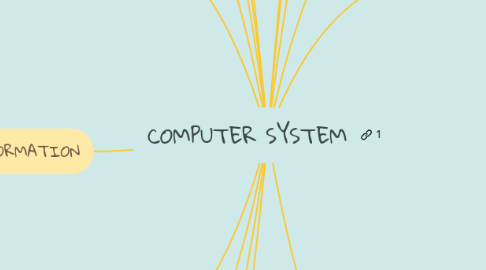
1. store instructions waiting to be excecuted by the processor
2. OUTPUT DEVICE
3. MEMORY
3.1. function
3.2. type
3.2.1. Volatile (RAM)
3.2.1.1. temporary: loses its contents when the power is turned off
3.2.1.1.1. types
3.2.2. Nonvolatile (ROM)
3.2.2.1. parmanentlyL does not lose contents when the power turned off
3.2.2.1.1. types
4. HARDWARE
4.1. INPUT DEVICE
4.2. SYSTEM UNIT
4.3. STORAGE DEVICE
4.4. COMMUNICATION DEVICE
5. INFORMATION CODING SHEME ( ICS )
5.1. ASCII
5.2. EBCDIC
5.3. UNICODE
6. DATA VS INFORMATION
6.1. DATA
6.1.1. Data is raw, unorganized facts that need to be processed, such as character, number, text, video, image, audio.
6.2. INFORMATION
6.2.1. INFORMATION PROCESSING CYCLE
6.2.1.1. INPUT
6.2.1.1.1. the process of entering data into memory of computer
6.2.1.2. OUTPUT
6.2.1.2.1. the process of conveying information to the user
6.2.1.3. PROCESS
6.2.1.3.1. the process of transforming data into information
6.2.1.4. STORAGE
6.2.1.4.1. the process of saving data, programs, instruction or output for future use
6.2.2. Information is data that has been processed in such a away as to be meaningful to the person who receives it. Value added to data such as summarize, organize and analyze.
7. DATA REPRESENTATION
7.1. Bit
7.2. Byte
8. NUMBER SYSTEM
8.1. Decimal (Base 10)
8.2. Binary (Base 2)
8.3. Hexadecimal (Base 16)
9. STORAGE
9.1. TYPES
9.1.1. magnetic storage
9.1.2. optical storage
9.1.3. flash memory
9.2. STORAGE CAPACITY
10. LOGIC GATE
10.1. AND
10.2. OR
10.3. NOT
10.4. NAND
10.5. NOR
11. backup and restore
12. sound card
13. ADAPTER CARD
13.1. FUNCTION
13.1.1. Ehances functions of a component of the system unit and/or provides connection to peripherals
13.2. type
13.2.1. firewire card
13.2.2. modem card
13.2.3. network card/ NIC
13.2.4. USB card
13.2.5. Video/ graphic card
13.2.6. MIDI card
13.2.7. TV tuner card
13.2.8. PC-to-TV converter card
14. PROCESSOR
14.1. COMPONENTS
14.1.1. CONTROL UNIT (CU)
14.1.1.1. provides connectors for other peripherals
14.1.2. ARITHMETIC LOGIC UNIT (ALU)
15. MOTHERBOARD
15.1. FUNCTION
15.1.1. Holds many components of the system
15.2. BASIC COMPONENT
15.2.1. Processor slot
15.2.2. Memory slot
15.2.3. Adapter card slot
16. SOFTWARE
16.1. TYPES
16.1.1. SYSTEM SOFTWARE
16.1.1.1. utility program
16.1.1.1.1. types
16.1.1.2. Operating system
16.1.1.2.1. types
16.1.1.2.2. function
16.1.2. APPLICATION SOFTWARE
16.1.2.1. types
16.1.2.1.1. web browser
16.1.2.1.2. word processing
16.1.2.1.3. spreadsheet
16.1.2.1.4. database
16.1.2.1.5. presentation
